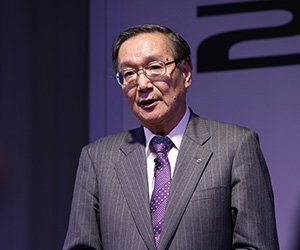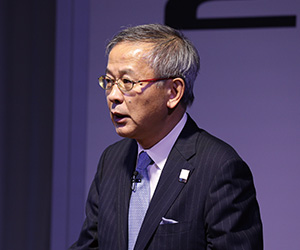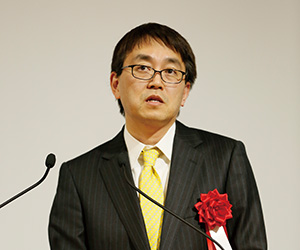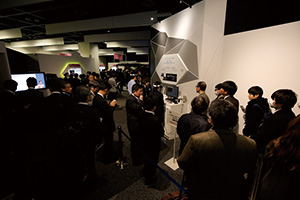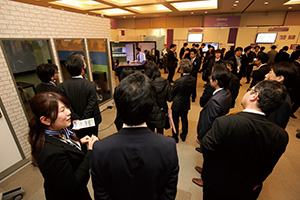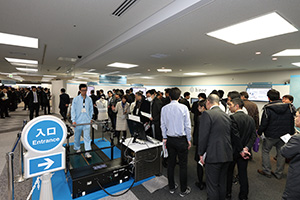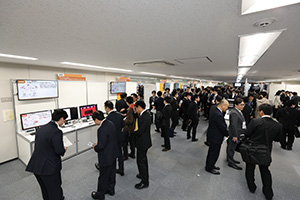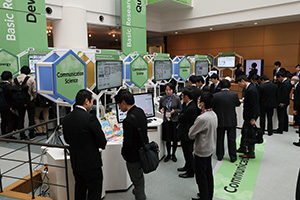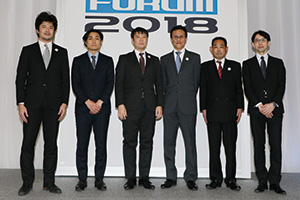 |
|
|
|
|
|
Information Vol. 16, No. 5, pp. 45–50, May 2018. https://doi.org/10.53829/ntr201805in1 Report on NTT R&D Forum 2018AbstractNTT held NTT R&D Forum 2018 at the NTT Musashino Research and Development Center for five days from February 19 to 23, 2018, with February 19 and 21 set aside solely for the press and NTT Group employees. This article reports on the lectures and exhibits presented in the forum. Keywords: R&D Forum, corevo, latest technology 1. Forum overviewThe NTT Group is fully committed to being a value partner that continues to be sought after by customers. NTT R&D Forum 2018 presented lectures and exhibits displaying the latest research and development (R&D) results and their role in this effort. The main concept of this year’s forum was Digital Technologies for a Brighter Future. Technologies related to artificial intelligence (AI), Internet of Things (IoT), media, user interfaces (UIs), networks, and security were introduced. To facilitate visitors’ understanding of the latest R&D in these areas, presentations featured business cases in which research results have been commercially applied. Attendance was high and included NTT Group customers in Japan and around the world, business partners, IR (investor relation) stakeholders, and people from government agencies and universities. 2. Lectures and workshopsOn February 20, Hiroo Unoura, NTT President and CEO, gave a keynote address entitled “Co-creating a Virtuous Cycle of New Value,” in which he talked about the B2B2X (business-to-business-to-X) model, an initiative NTT is pursuing together with partners to create new value by supporting digital transformation in a variety of fields. This initiative is aimed at implementing Society 5.0, which is a Japanese government strategy to accelerate the penetration of digital technologies into government, industry, and society by developing innovative technologies and utilizing a diverse range of data. For this initiative, the NTT Group is collaborating with players in various fields, including entertainment, sports, automotive, transport, manufacturing, and environmental protection. To promote digitization of industry and society and accelerate the realization of Society 5.0, NTT is proposing to build a Japanese-model ecosystem, in which a consortium of industry, academia, and government participants formed in each regional block collects and utilizes data. As the first step, NTT concluded the Sapporo Town Planning Partner Agreement with Sapporo City. According to this agreement, three companies—namely, a department store, supermarket, and drugstore—have brought together their information about purchases made by inbound tourists so that they can analyze the data to a greater extent possible than when using only the information owned by individual companies. These analyses have enabled them to revise their marketing strategies, resulting in the creation of new earning opportunities. The success in this unprecedented value creation prompted more than 20 companies to participate in this joint effort. This is expected to give rise to the development of new applications such as using the collected data to implement electronic payment systems or to share information about the operation of snow plow trucks. NTT is pushing nationwide deployment of this Japanese-model ecosystem by expanding it from Sapporo City to the entire Hokkaido region and to other parts of the country. President Unoura expressed his commitment to bringing about Society 5.0 and to promoting value creation by supporting digital transformation in a variety of fields in collaboration with partners (Photo 1).
This address was followed by another keynote by Hiromichi Shinohara, NTT Senior Executive Vice President and Head of the Research and Development Planning Department, entitled “Creating a Prosperous Future through the Fruits of R&D.” He introduced NTT’s R&D activities for strengthening industrial competitiveness such as improving productivity and empowering individuals, and NTT’s efforts to overcome social problems such as by promoting safety, preventing disasters, revitalizing local economies, and ensuring a sustainable global environment. Advances in information and communication technology make it possible to understand the intent of consumers and to provide services and information in a natural manner without requiring consumers’ conscious action. Thus, future technologies will be such that they enter our daily lives more naturally than before. Enterprises will be able to provide products that detect changes in customers’ behavior and use collected data to remain more closely connected with their needs. NTT considers AI, IoT, media, UI, networks, and security as key technical fields in which further R&D will help address social issues. Mr. Shinohara introduced the latest technologies in these fields (Photo 2).
In a workshop held on February 22, Hiroshi Nakamura, Executive Vice President, Chief Technology Officer, and Executive General Manager of the R&D Innovation Division of NTT DOCOMO, talked about the company’s R&D activities under the title “Co-creation Generates Smart Innovation – DOCOMO’s Strategy Toward 5G.” He introduced the fifth-generation mobile communications network (5G), which enables high-speed, high-capacity, and low-delay transmission and connections with numerous terminals, and presented cases of co-creation with partner enterprises with a focus on corevo®, the NTT Group’s initiative to utilize its AI-related technologies. This workshop was followed by a special lecture entitled “The Future of the AI Era” by Yoshiharu Habu, professional shogi (Japanese chess) player. He acknowledged that shogi is a field susceptible to AI technology and talked about how AI is affecting humans. He first looked back at the history of using AI in games. He stated that the dramatic improvement in performance in recent years is enabling AI to analyze a large number of possible moves of pieces, which is in contrast to humans, who are good at developing a big-picture strategy to determine the next moves to make. It has become routine for younger members in the shogi world to use AI to study strategies. This has resulted in the revival of once-abandoned strategies and the discovery of bold moves that only AI can conceive, since unlike humans, it is fearless. He said that in this new environment, it has become even more important for shogi players to bring to bear aesthetics, originality, and identity in countering moves made by AI (Photo 3).
Two workshops took place on February 23. First, Ryutaro Kawamura, Vice President of NTT Network Innovation Laboratories, introduced cases in which value is created using IoT together with partners, in a workshop under the title of “IoT Activities in NTT and Its Future.” Next, Hiroki Takesue, Senior Distinguished Scientist, NTT Basic Research Laboratories, gave a lecture entitled “Quantum Neural Network: a New Computer Using Light” that featured a computer system that uses various networked light emitters (lasers) to rapidly solve optimization problems that arise in various contexts in modern society. These lectures introducing NTT’s R&D activities were well received by the audience. 3. Exhibits of research results and sessions dedicated to specific themesUnder the concept of Digital Technologies for a Brighter Future, the forum presented 123 exhibits (about 30% more than last year’s event) on the latest R&D results, which were classified into five selected exhibit themes: media & UI, corevo, IoT, network & security, and basic research. In addition, NTT Group companies, including NTT DOCOMO, NTT DATA, NTT Communications, NTT WEST, NTT EAST, and NTT i3, contributed exhibits covering a wide range of technologies, from those in the basic research stage to those that have been introduced commercially. To enhance visitors’ appreciation of the latest R&D results, exhibits were grouped in five main sites, and depending on the nature of the research, some were presented outdoors or in individual rooms, and some involved unique demonstrations. 3.1 Media & UIMedia processing technologies that provide user experiences with a high sense of reality and UI technologies that allow services to be tailored to individual users were introduced. (1) Media technologies that create new value This year, the immersive telepresence technology “Kirari!” was introduced in several usage situations together with its element technologies. In a theater-type exhibit, NTT collaborated with a stage director to produce a new sense of excitement with Kirari!. In addition, two new forms of Kirari! were exhibited: “Kirari! For Arena,” which makes a new spectator experience possible by transmitting data representing the entire arena’s interior, thereby enabling the user to view the arena environment from four different angles, and “Kirari! For Mobile,” which works with a smartphone to enable the user to easily view a three-dimensional (3D) video. In addition, a wide range of media technologies were introduced. “HenGenTou (Deformation Lamp)” uses some characteristics of human visual processing to create the illusion that parts of a photo or a picture are moving. “Hidden Stereo” is a stereoscopic video generation technology that provides a video that appears as a clear 2D video to the naked eye, but as a 3D video when the viewer puts on dedicated glasses (Photo 4).
(2) UI technologies for 202X Technologies for diversity navigation were also exhibited. These technologies are aimed at making mobility in everyday life safer and easier. Specifically, 2.5D map position search technology provides easy-to-understand navigation with simple spoken words so that the user does not need to look up a map. Walking guide technology is aimed at enabling visually impaired persons to walk to their destinations without anxiety. There were also exhibits that introduced a wide range of UI technologies. For example, communication facilitating technology enables a natural dialog between a human and an agent played by a robot. 3.2 corevoSeveral exhibits introduced “corevo,” an initiative that embraces the NTT Group’s-AI related technologies and services. This initiative is being accelerated so that new value will be created using AI, which is attracting interest in a wide variety of fields. (1) AI that supports people Agent-AI technologies were introduced that analyze speech to understand the speaker’s intention and emotion, and to provide responses in a manner as natural as those of humans. corevo@Home enables an agent to understand speech correctly and to carry out a natural dialog, while corevo@ServiceDesk understands the intention of a customer’s questions and provides service desk operators with the most appropriate information. Cross-lingual speech synthesis technology synthesizes speech in different languages using the user’s voice (Photo 5).
(2) AI that supports society Ambient-AI technologies are aimed at analyzing information about humans, things, and events, and making instantaneous prediction or control possible. For example, learning-based guidance technology to estimate the flow of people from observed data on the number of people in a certain area was introduced. This technology also uses simulation to help develop an optimal guiding policy. It consists of multidimensional composite data analysis technology and spatiotemporal variables-based online-prediction technology that together predict upcoming changes from various kinds of data collected across time and space. It also uses machine learning technology. (3) Core technologies that support corevo Technologies that support the implementation of corevo technologies and services were introduced. Learning acceleration technology improves the stability and speed of deep learning. Encoding technology represents a huge volume of spatial information data with a small number of feature values. 3.3 IoT(1) Sense, Connect & Drive Technologies were introduced that digitize and transmit information about events that are detected by interpreting data about things. The technology of the biosensing fabric “hitoe” was introduced, together with its use in a growing variety of fields, including healthcare. Also exhibited was technology for extending the distance covered by LoRa, which collects data from sensor terminals in places that are hard for radio waves to reach (Photo 6).
(2) Data & Software Logistics IoT data exchange technology enables high-speed data exchange between devices and lends itself to applications in manufacturing, as well as in automobile and ship control. Edge computing technology makes real-time distributed processing possible so that a large volume of data can be processed with low delay. (3) Analysis & Prediction Research results that combine big data analysis and deep reinforcement learning in the IoT field were introduced under the category of corevo. For example, device control technology analyzes people flows and the energy consumption of building equipment in order to optimize the control of air-conditioning and other active structural accessories. 3.4 Network & securityNetwork and security technologies aimed at enriching future society were introduced in four categories. (1) Smart network operation Technologies for operations that are smart and yet do not demand high skill will be required for network construction and management in the future. Technologies that use AI to support network operators or to predict imminent failures were introduced (Photo 7).
(2) Technologies that enhance network speed The age of 5G is near, and 5G-related technologies that enable high-speed transmission and the construction of high-capacity optical networks were exhibited. (3) Flexible and efficient networks A wide range of technologies and activities were introduced that are aimed at building flexible and efficient networks with general-purpose devices or based on new architecture, such as SDx (software-defined anything) control. (4) Security in the era of IoT/AI Security technologies that can be applied in a wide variety of fields were exhibited. They included multi-party key exchange, secret-sharing, and anonymization technology. 3.5 Basic researchBasic research that will open up new horizons, and leading-edge research that will transform society by developing eco- and human-friendly technologies were introduced. The field of basic research was divided into four subthemes: communication science, quantum applications, energy manipulation, and devices. A total of 15 research results were exhibited and viewed by many visitors. Four technologies attracted special interest: tactile technology that gives a person a false sense of irregularity on a flat magnetic sheet; a biodegradable battery that decomposes into soil to minimize its impact on nature and living things; LASOLV—a quantum neural network that solves complex optimization problems at high speed; and new display device technology derived from optical circuit technologies that have been developed for optical communication. In addition, some exhibits were more popular than had been expected. The basic research exhibit site was livelier than in previous forums (Photo 8).
On February 22, a live niconico interview took place at the forum site and was broadcast on the niconico website. The topic of the interview was the biodegradable battery. Young researchers involved in this project introduced their research results, intermixed with talks about their aspirations and private lives. The interview made the research easy to understand and was also entertaining. 4. ConclusionThis year, the forum was attended by about 16,000 people, a dramatic increase over last year. We believe that rising expectations for NTT’s R&D were the reason for the growth in the number of participants. This was substantiated by voices heard at the forum site and in responses to our questionnaire survey. To meet these ardent expectations for our R&D, we will make even greater efforts to develop and deploy new technologies.
|
|









